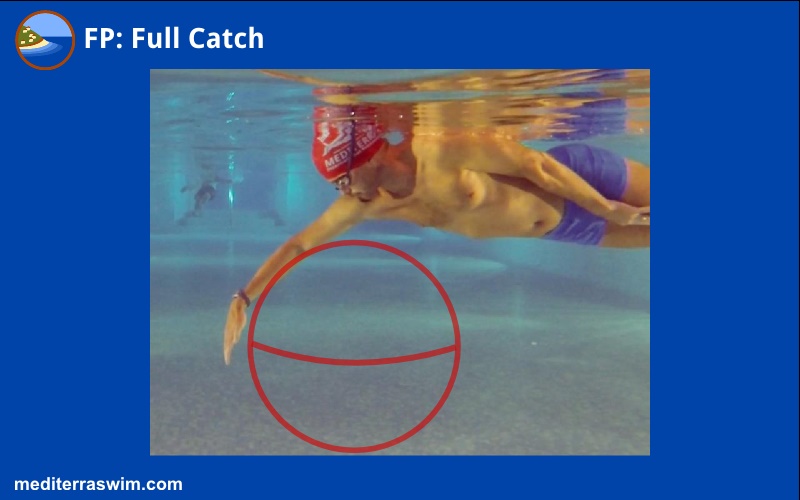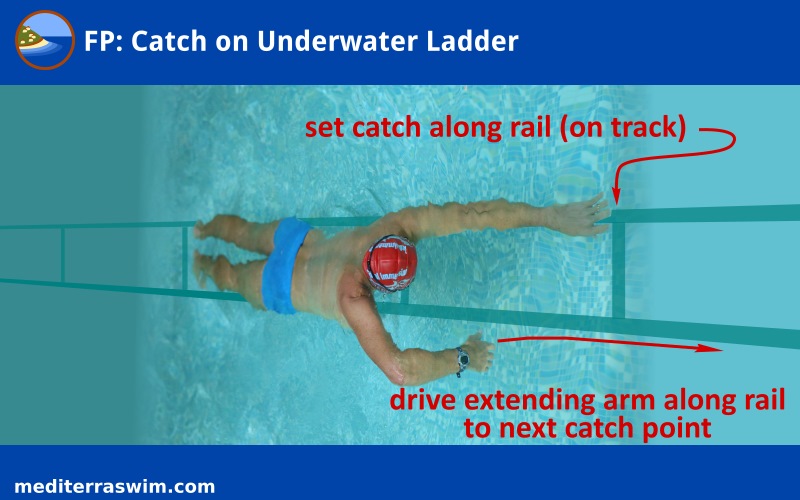Forums › Library › Knowledge Base › Catch Tutorial
Please type your comments directly in the reply box - DO NOT copy/paste text from somewhere else into the reply boxes - this will also copy the code behind your copied text and publish that with your reply, making it impossible to read. Our apology for the inconvenience, but we don't see a convenient way of fixing this yet.
Tagged: catch, focal points, propulsion
-
AuthorPosts
-
October 26, 2017 at 18:02 #15715
Mat Hudson
KeymasterThe purpose of the catch is:
- To anchor the hand, or to get a grip on the water, in order to
- Slide the body past that point
The primary action of the freestyle stroke is to drive the entry/extension arm forward in the water on one side of the body. The secondary action or supporting role is the catch/anchor on the other side of the body. These two actions occur simultaneously. Power is generated by the rotation on the catch side of the body and transferred instantaneously, and smoothly to the lead arm side of the body.
The ideal arm-switch timing must be established first before the catch skills will have their intended effect. The catch will be generating force but cannot send it to the other side of the body, if that other side of the body is not positioned to direct it forward through the entry/extension arm.
Beach Ball Analogy

In order to help form the shape of the catch we provide the image of a beach ball (or pilates ball, or swiss ball, or medicine ball – which ever you prefer). You create a pressure zone of water by shaping your arm as if sliding over the top and pressing against this ball, in the opposite direction you intend to travel. If you press the ball in any other direction than straight back, your body (particularly, your head) will be urged to move in the opposite direction, away from straight forward.
Ladder Analogy

In order to set position and trajectory of the catch we provide you with the image of a ladder placed underwater, parallel to the surface. Each rail lines up with each of your shoulders, on each arm track. Each rung on this ladder is positioned at the point where you will anchor the hand (or we say ‘set the catch’), and then slide your body forward, up that ladder, past the anchor point. Your entry/extension arm slides straight forward along the rail on that side.
Drills for Catch
- One-Arm Drill
- Swing Switch with pauses (at Skate Position and at entry moment)
- Swing Switch without pauses (slow-motion)
- Whole stroke at moderate tempo
Focal Points for Catch
- Set the Catch (just ‘touch the ball’ don’t pull on it yet)
- Hold the ball steady and rotate body past it
- Press the ball toward your hip (and then the hip rolls out of the way)
- Gradually increase pressure on the ball (don’t yank on it abruptly)
- Maintain constant, steady contact with the ball all the way through
- DO NOT SCULL or create S Curve (this is a sign of losing grip)
- Press the ball straight toward your toes
- Keep ‘arm-wrestle’ arm shape
The main skills you are forming in the catch are:
1. Shape
You are shaping the arm in such a way to get a better grip on that pressure zone of water. The better the shape, the better the grip, the more your body will be able to slide forward rather than have the catch hand slip backward in the water.
2. Timing
You set the catch and then hesitate every so slightly so that the torso has a chance to start turning and empower the catch. Pull too abruptly and the small shoulder muscles take over and stay committed to that work the whole way, and tired out quickly as a result. If you gradually increase pressure then the torso can take the load.
3. Pathway
If you want your body to slide straight forward then you must apply pressure directly backward and in no other direction. Keep the catch hand on track, on that side of the ladder rail. Press straight back with the intent of sliding the body straight forward. The better you execute the rotation, the easier it is to keep the catch hand on track, with no sculling, no S curve (which are signs of losing traction).
By sending the ball on this path you are able to slide your body over those pressure zones of water you create on each catch, especially giving support to the hips and legs. Therefore those balls of pressure need to be sent fairly shallow under the body, and straight back, toward the toes. These balls flow under the heavier hips and legs, assisting in their support, reducing or eliminating your need to kick to keep them up.
-
AuthorPosts
- You must be logged in to reply to this topic.
